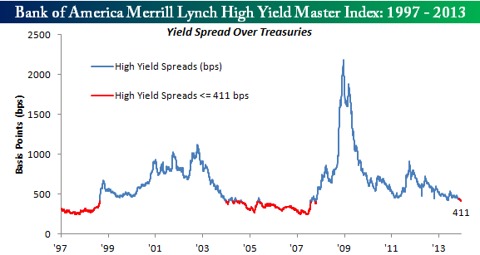After rising sharply in 2013, yields on the 10-year Treasury note have paused at 3% following a weak December jobs report, but the long-term trend for interest rates still looks to be higher.
Rising interest rates are a potential problem for fixed-income investors, since bond prices and yields move in opposite directions.
That’s one reason why some investors trying to earn extra income have recently been favoring bank loans instead of high-yield corporate bonds. Bank loans have decent yields but are structured as floating-rate securities with durations near zero, so they provide some protection against rising rates. Like high-yield bonds, bank loans are issued by companies with credit ratings below investment grade.
There are also concerns that high-yield corporate bonds may be overvalued with so many investors stretching for income in a low-rate environment. For example, Bespoke Investment Group recently took at look at the high-yield credit markets. The demand for high-yield bonds has pushed the yield spread between junk bonds and Treasuries of similar maturity to a six-year low.
The narrow spread means investors aren’t getting paid much for taking on the higher credit risk of high-yield bonds relative to Treasuries.
Chart source: Bespoke Investment Group
Fear of rising interest rates and a high-yield bond market that could be overvalued are a couple reasons why some investors are looking at bank loan funds and ETFs.
These funds typically buy speculative-grade loans used to finance buyouts. Again, since their rates are usually variable and the underlying debt is sometimes short in duration, the loans are less vulnerable to increases in interest rates. And they usually offer better yields than high-quality bonds.
Yet there are some caveats. Bank loan funds attracted $49 billion from investors in 2013, according to data compiled by Lipper. That’s more than the cumulative flow of money into them over the past eight years.
There are some concerns that investors rushing into bank loans for yield aren’t fully aware of the risks, so individuals should consider the potential downsides.
There are two additional factors worth considering when it comes to bank loan funds. Most charge relatively high fees when compared with the average bond fund and some use a fair amount of leverage, according to Morningstar. When used wisely leverage enhances gains–when things go bad, losses are magnified. Back in 2008, as the economy went into the tank, bank loan funds lost 30% of their value.
That said, John Gerard Lewis, who oversees the Stable High Yield Portfolio on Covestor, thinks bank loan funds can play a productive role in a balanced and diversified investment plan. Also, the U.S. economy is in far different shape in 2014 that it was in 2008. As Lewis explains:
“Yes, in the calamity of 2008, bank-loan funds tanked by about 30%. But they rebounded by an even greater percentage the next year and have soundly beaten, on an annualized total-return basis, the benchmark Barclays U.S. Aggregate Bond Index every year since. And that’s been during an era of still-declining interest rates. As rates begin to rise at some point in the next year or two, the paramount advantage of bank-loan funds should reveal itself: the combination of impressive yield with almost nonexistent duration.”
Lewis has exposure to bank loans in Stable High Yield Portfolio with a position in PowerShares Senior Loan Portfolio ETF (BKLN). The fund has a yield of about 4%.
Photo Credit: stu_pendousmat
DISCLAIMER: The investments discussed are held in client accounts as of December 31, 2013. These investments may or may not be currently held in client accounts. The reader should not assume that any investments identified were or will be profitable or that any investment recommendations or investment decisions we make in the future will be profitable. Past performance is no guarantee of future results.






